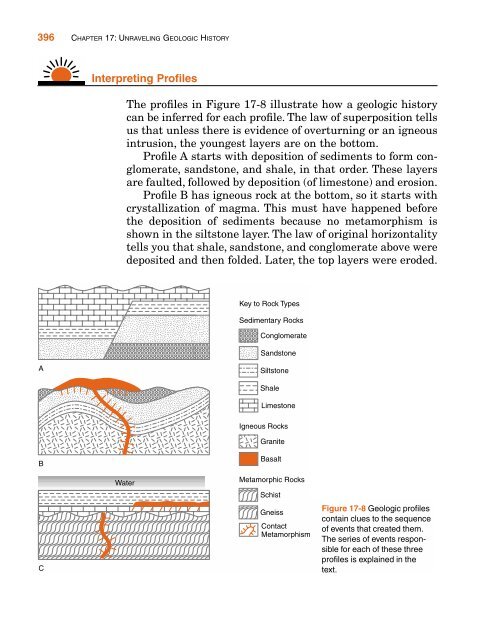Chapter 17 Unraveling Geologic History
Chapter 17 Unraveling Geologic History
Chapter 17 Unraveling Geologic History
Create successful ePaper yourself
Turn your PDF publications into a flip-book with our unique Google optimized e-Paper software.
396 CHAPTER <strong>17</strong>: UNRAVELING GEOLOGIC HISTORY<br />
A<br />
B<br />
C<br />
Interpreting Profiles<br />
The profiles in Figure <strong>17</strong>-8 illustrate how a geologic history<br />
can be inferred for each profile. The law of superposition tells<br />
us that unless there is evidence of overturning or an igneous<br />
intrusion, the youngest layers are on the bottom.<br />
Profile A starts with deposition of sediments to form conglomerate,<br />
sandstone, and shale, in that order. These layers<br />
are faulted, followed by deposition (of limestone) and erosion.<br />
Profile B has igneous rock at the bottom, so it starts with<br />
crystallization of magma. This must have happened before<br />
the deposition of sediments because no metamorphism is<br />
shown in the siltstone layer. The law of original horizontality<br />
tells you that shale, sandstone, and conglomerate above were<br />
deposited and then folded. Later, the top layers were eroded.<br />
Water<br />
Key to Rock Types<br />
Sedimentary Rocks<br />
Conglomerate<br />
Sandstone<br />
Siltstone<br />
Shale<br />
Limestone<br />
Igneous Rocks<br />
Granite<br />
Basalt<br />
Metamorphic Rocks<br />
Schist<br />
Gneiss<br />
Contact<br />
Metamorphism<br />
Figure <strong>17</strong>-8 <strong>Geologic</strong> profiles<br />
contain clues to the sequence<br />
of events that created them.<br />
The series of events responsible<br />
for each of these three<br />
profiles is explained in the<br />
text.
















